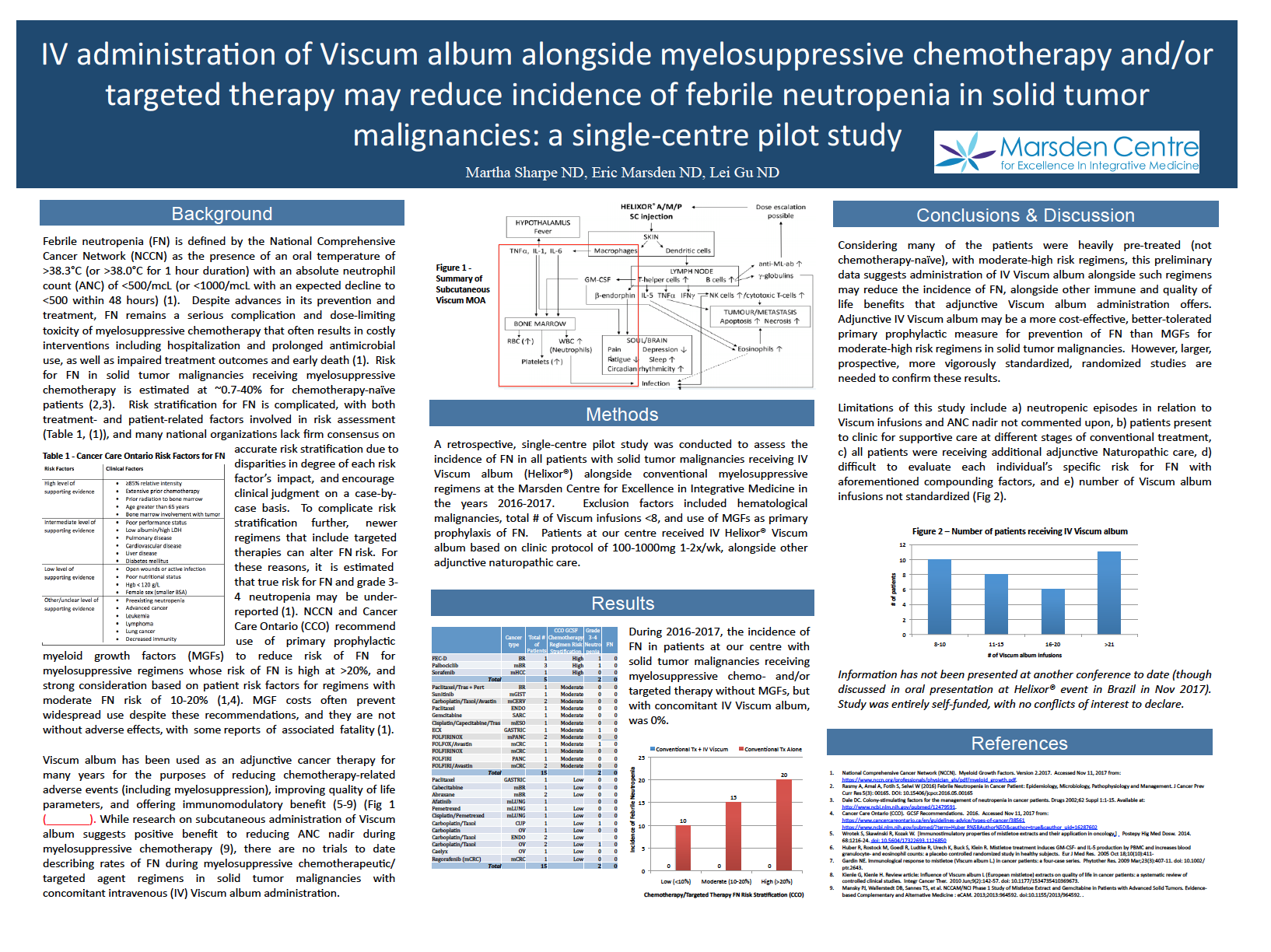Presented or Published Research
By Marsden Centre MembersWe are proud to be involved in the presentation and publication on several important integrative medicine topics. It is rare that a health centre not directly connected with an educational institution is able to complete clinical and/or scientific research. This has been made possible through the work of our clinic naturopathic doctors, most notably our clinic residents.
Poster Presentation ONCANP 2018:
IV administra,on of Viscum album alongside myelosuppressive chemotherapy and/or targeted therapy may reduce incidence of febrile neutropenia in solid tumor malignancies: a single-centre pilot study
Viscum album has been used as an adjunctive cancer therapy for many years for the purposes of reducing chemotherapy-related adverse events (including myelosuppression), improving quality of life parameters, and offering immunomodulatory benefit. While research on subcutaneous administration of Viscum album suggests positive benefit to reducing ANC nadir during myelosuppressive chemotherapy (9), there are no trials to date describing rates of FN during myelosuppressive chemotherapeutic/targeted agent regimens in solid tumor malignancies with concomitant intravenous (IV) Viscum album administration. In this study we examined the rates of FN in patients receiving IV viscum in addition to conventional chemotherapy regimes at our centre over a period of 2 years. Click on the image to download or view the poster.

Single Institutional Experiences With Intravenous Viscum in Cancer Patients
The use of intravenous viscum album is a novel way to administer viscum providing unique therapeutic options to support cancer patients. In this presentation we will review the use of intravenous viscum (Helixor) therapy in a single institution, outpatient setting. We will review:
- Institutional infusion treatment protocols and rationales
- Treatment safety including observed adverse reaction rates and there treatment
- Clinical effects including how intravenous infusions of Viscum (Helixor) can address myelosupression, cancer related pain, augmenting treatment response through case reports of use in patients
Safety of Naturopathic Infusion Therapy (Quality Assurance Study)
Given the increasing usage of naturopathic medicine and the increased number of practitioners performing this therapeutic modality it is important to know the safety profile of NIT. One recent article attributed a severe reaction to a “naturopathic infusion” it is unknown whether the practitioner responsible for administering this treatment was a licensed naturopathic doctor who was trained to perform such a procedure. Clearly, given the increased interest and demand for NIT, there is a need to validate the safety of these treatments. The goal of this study is to review the rates of complications related to the procedure and rates of adverse reactions to the substances being administered in a typical outpatient setting performing NIT, and to compare that with published rates in a conventional setting.


Non-Conventional Supportive Care During FOLFOX/FIRI Treatment
Colorectal Cancer is treated using various chemotherapeutic regimens. Folinic acid (FOL) is usually combined with fluorouracil (F) and either irinotecan (IRI) or oxaliplatin (OX) to further improve response rates and prolong survival. Both combinations (FOLFIRI and FOLFOX) are approved as standard treatment for metastatic colorectal cancer. (Goldberg 2007) (Kono 2009) (Wrzesinski 2007)
Despite the notable improvements in overall survival with these therapies they are not without significant side effects. One of the largest concern for these conventional therapies include neurotoxic effects of oxaliplatin and which can become dose-limiting, (Kono 2009) (Kurniall 2010) (Nishioka 2011) leading to inability to finish prescribed regimens.
In more than 90% of patients, oxaliplatin causes both a reversible cold-related dyesthesia and a dose-limiting chronic peripheral sensory neuropathy in 10-18% of patients after 4-6 months when the cumulative dose of oxaliplatin approaches 800mg/m2. (Milla 2009)
In a majority of cases where these chemotherapeutic regimens produce a response, virtually all responses are incomplete and emergence of resistance and recurrence of cancer is universal. (Patel 2010) The question then becomes what can be done to improve patient tolerability and success of these conventional regimens to maximize outcomes for patients.
A novel form of dichloroacetate therapy for patients with advanced cancer: a report of 3 cases.
Abstract
Oral dichloroacetate sodium (DCA) is currently under investigation as a single agent and as an adjuvant for treatment of various cancers. One of the factors limiting its clinical use in a continuous oral regimen is a dose-related, reversible neurotoxicity, including peripheral neuropathy and encephalopathy. The intravenous (IV) route has a number of potential advantages, including (1) pulsed dosing to achieve higher concentrations than feasible with oral use, (2) a longer washout period to reduce the potential for neurotoxicity, and (3) a bypassing of the digestive system, which is particularly significant for advanced-stage cancer patients. Data were available on high-dose IV DCA (up to 100 mg/kg/dose) that have confirmed its safety, both in healthy volunteers and in critically ill patients, allowing the authors to begin off-label treatment of cancer patients. In several of their patients treated with IV DCA, the authors observed clinical, hematological, or radiological responses. This article presents 3 cases with patients who had recurrent cancers and for whom all conventional therapies had failed: (1) a 79-y-old male patient with colon cancer who had liver metastases, (2) a 43-y-old male patient with angiosarcoma who had pancreatic and bone metastases, and (3) a 10-y-old male patient with pancreatic neuroendocrine carcinoma who had liver metastases.
